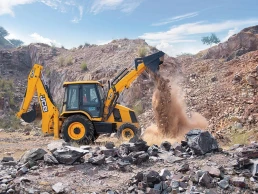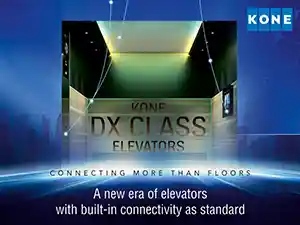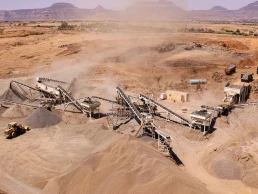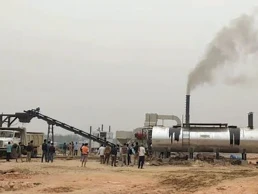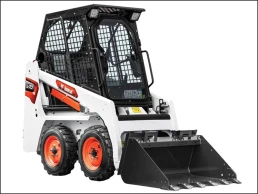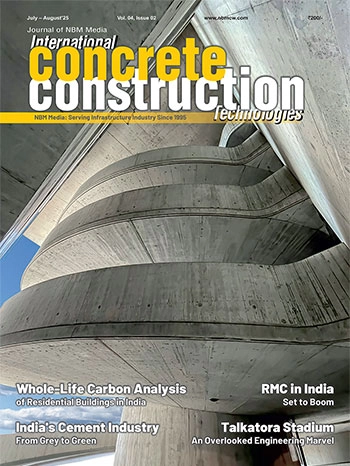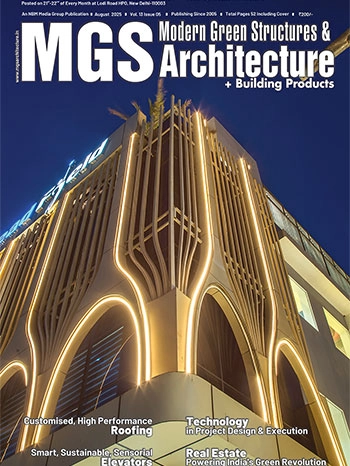Durability and Sustainability of Hardened Concrete
Concrete is widely used in construction, yet its longevity and sustainability often go unnoticed until signs of premature deterioration appear. To truly understand how to extend its service life, it is crucial to explore the factors that influence its performance in the hardened state.
In this article, Sasanka Sekhar Dey, General Manager, JP AUTOCLAVERS & CO., explores key durability challenges, gives valuable insights on optimizing mix design, emphasizes the importance of material selection and exposure assessments, and discusses testing methods and the relationship between durability and sustainability in concrete. These factors play a significant role in contributing to efficient, long-lasting construction practices.

Concrete durability and sustainability are two important parameters that enhance the service life of concrete structures for the desired time period. However, due to volumetric changes in the hardened state of concrete, the service life is reduced, and the deterioration of the structures is accelerated. As a result, the strength of hardened concrete structures is significantly affected and can be reduced. It is also important to note that if the concrete strength is found to be high at the initial stage, such as during the 28-day strength test, it does not necessarily validate that its durability is also high. Over time, strength may decrease if the structures are not impermeable, which would compromise the durability.
The durability of a concrete structure refers to the ability to extend its service life according to the targeted design lifespan. In simple terms, durability compromise in concrete means the loss of mass within the system due to various types of deterioration. In concrete, water is the main culprit for both durability and sustainability. Excess water in the concrete can accelerate its degradation. Moreover, the loss of durability in concrete structures can be caused by both external conditions, such as climatic changes (hot or cold weather), which can lead to volume changes or aggregate volumetric expansion, and internal conditions (chemical reactions within the hardened concrete), which weaken the concrete structures and affect their ability to meet the required specifications.
Durability mechanisms can generally be classified into two types: the deterioration mechanism, such as corrosion of rebars, chemical attacks, ASR/DEF, and the transport mechanism, such as permeability, porosity, chloride diffusion, absorption, etc.

Hardened concrete durability is generally categorized into two types:
A. Physical Durability: Durability caused by self-external factors is referred to as physical durability. This type is generally further divided into three categories, as outlined below:
1. Freezing and Thawing Effect: Freezing and thawing of concrete is a physical deterioration process that occurs in cold environments, where ice forms and breaks the bonds in the cement around the aggregate. This extends the stresses within the hardened concrete, leading to cracks and damage in the concrete structures. The freezing and thawing cycle repeats with the seasons, wearing out the concrete over time. Porous, saturated concrete with no empty voids is more vulnerable to this effect. As stated in ACI 201.2R-16, the entrained air void system can be measured by following three key factors to resist and prevent the freezing and thawing effects in concrete.
- Spacing Factor: A distance generally ranging from 0.1 mm to 1.00 mm is required (the larger the distance between the cement paste and the air voids, the better the distribution), but 0.20 mm is recommended for freezing and thawing (F&T) effects.
- Surface Area Factor: Larger voids have a lower surface area, while smaller voids, which are evenly distributed throughout the concrete, have a higher surface area. A surface area of generally 25 mm²/mm³ is recommended for this factor.
- Philleo Factor: This refers to the distance from an air void within which a given percentage of paste is located. The Philleo factor is often compared with the spacing factor. However, the Philleo factor is more sensitive to the actual air void distribution than the air content, paste content, and the number of voids that influence the spacing factor.
For F&T effects in concrete, a water-to-cement (w/c) ratio of a maximum of 0.45, with adequate curing and a compressive strength of no less than 25 MPa, can easily resist the effects of repeated F&T cycles. A minimum compressive strength of 3.5 MPa can resist the first (one) F&T cycle, while a minimum of 25 MPa can resist repetitive F&T cycles. Both aggregates and cement paste can expand due to the F&T effect in the system. D-cracking and pop-out are common phenomena resulting from these effects.
 As per BS-EN 206 part 1 -2000 wise Exposure condition are as Above:
As per BS-EN 206 part 1 -2000 wise Exposure condition are as Above:
To protect against F&T effects during cold seasons, the application of air entrainment with proper spacing, as described above, can significantly help protect the concrete from these effects.
By applying an air-entraining admixture, lowering the W/C ratio, adding supplementary cementitious materials (SCMs), and increasing the cover depth, we can protect against the effects of freezing and thawing (F&T). The air-entraining admixture provides air entrainment into the hardened concrete system, which can be measured in both the fresh and hardened properties of the concrete as per ASTM C173/231 and ASTM C457, respectively. Other beneficial effects of SCMs will also help enhance resistance to these effects.

As per ACI 211.1-22, ACI 301-20, and ACI 318-19, the required entrained air content is based on the nominal maximum aggregate size (NMAS) to protect the concrete from freezing and thawing effects.
 L-R: Exposure classes to protect the freezing and thawing effects & As per stated in ACI 211.1-22, ACI 301-20 and ACI 318-19 wise
L-R: Exposure classes to protect the freezing and thawing effects & As per stated in ACI 211.1-22, ACI 301-20 and ACI 318-19 wise
2. Permeability to both Gases and Liquids: The permeability of concrete refers to its ability to allow liquids or gases to pass through it. It is a measure of the amount of water, air, and other substances that can penetrate the concrete matrix. Concrete contains pores that enable these substances to enter or exit. Permeability can be a primary cause of concrete deterioration due to reinforcing steel corrosion and other deterioration mechanisms. On a macro scale, permeability also refers to "permeable" slabs (made of permeable concrete) used for draining pavements, sidewalks, and parking areas, thereby eliminating the need for drainage slopes, structures, and piping.
 The application of SCMs in air-entrained concrete for the F3 category:
The application of SCMs in air-entrained concrete for the F3 category:
Porosity of Hardened Concrete: The presence of voids in hardened concrete refers to the ratio of the apparent volume of voids to the volume of solids, which is known as the porosity of the concrete structure.
Permeability: When the porosity of hardened concrete becomes interconnected, due to external loads or environmental exposure conditions, it transforms into a permeable structure. This is known as the permeability of the hardened concrete.

3. Heat of Hydration of Concrete Structures: The heat of hydration is the heat generated when water reacts with Portland cement. It is an exothermic chemical reaction that creates new bonds and forms more stable cement hydrates. The amount of heat released depends on factors such as the cement composition, curing temperature, water-to-cement ratio, and cement fineness.
The heat of hydration is particularly important in mass concrete, as it can affect the strength, durability, and cracking of the concrete due to thermal stresses (the temperature difference between the core section and the outer surface of mass or large-dimensional concrete sections). The temperature and the rate at which hydration occurs significantly influence the strength and durability of concrete.

Excessive heat of hydration can cause non-linear temperature distributions, leading to tensile stresses that may exceed the strength of young concrete, resulting in cracks. The influence of temperature on cement hydration is reflected in both the properties of the concrete mixture and the hardened concrete. In the section on mass concrete, a detailed discussion is provided on the temperature differential from core to surface, core to ambient temperature, and methods to maintain these temperature variations.

B. Chemical Durability: Durability in concrete structures resulting from chemical reactions or attacks by any types of chemical agents is referred to as the chemical durability of concrete. This category is generally divided into four types, as outlined here:
 As per the code guidelines of ACI 318-19, ACI 301-20, and ACI 211.1-22, the exposure conditions can be divided into four categories:
As per the code guidelines of ACI 318-19, ACI 301-20, and ACI 211.1-22, the exposure conditions can be divided into four categories:
- Freezing & Thawing effect- F
- Sulphate content effect in concrete- S
- Concrete contact with Water- W
- Corrosion protection of reinforcement- C
1. Sulfate Attacks: Fresh concrete contains limited sulfate ions, but if the maximum limits are exceeded, it can severely impact the durability of concrete structures. According to standard code provisions, the limits for sulfate ions are specified in various international standards. Also, if fresh concrete is laid in an area with high sulfate ion concentration (compared to other areas), the durability of the concrete may be reduced, and its strength will also decrease. Sulfate Attacks can be classified into two types:
 As per DEF reducing by recommendation by ACI 201.2R-16
As per DEF reducing by recommendation by ACI 201.2R-16
Internal: Delayed Ettringite Formation (DEF) occurs when C3A reacts with sulfate ions present in the system.
External: When sulfate ions (SO3) enter through external sources and react with cement particles (C3A). Naturally occurring sulfates, such as sodium, potassium, calcium, or magnesium, which can attack hardened concrete, are sometimes found in soil or dissolved in groundwater near concrete structures.
Delayed Ettringite Formation (DEF) Early primary ettringite forms during the normal hydration process, while late primary ettringite forms when more SO3 is available in the system, either from the cement or other sources. First, gypsum is formed, and then gypsum reacts with aluminates (C3A) to form ettringite. This process continues as long as more SO3 is available in the system, ultimately leading to DEF, also known as secondary ettringite formation.
CaOH2+SO4=CaSO4+H2O (Gypsum formation)
(CaSO4+H2O)+C3A = Ettringite (Tri calcium sulphate)
Also, monosulfate reacts with the presence of sulfate ions and C3A, forming tricalcium sulfate. Due to ettringite formation, the cement paste expands throughout the matrix, and the C-S-H gel progressively loses its stability due to a significant drop in the surrounding pH level. As Ca(OH)2 is consumed to form gypsum, the pH level decreases. This reduction in pH causes C-S-H to lose its stability, becoming softer, which ultimately leads to a significant loss of strength in the cement mortar. Ettringite is not stable in very low pH conditions, such as acidic environments, and it remains stable only in alkaline conditions with a high pH content.
 As per the figure stated above, A has lower permeability and higher porosity than B, because interconnectivity does not occur in A, as the pores are not connected to each other, whereas B has higher permeability and lower porosity.
As per the figure stated above, A has lower permeability and higher porosity than B, because interconnectivity does not occur in A, as the pores are not connected to each other, whereas B has higher permeability and lower porosity.
At this point, the role of cations becomes essential to increase the level of alkalinity in the system. As a result, the presence of NaSO4 reacts with CaOH2 and formed NaOH2 and Gypsum as below-
NaSO4+CaOH2= NaOH2+CaSO4
NaOH2 provides alkalinity to the system and prevents C-S-H from losing its stability. Since C-S-H loses stability in acidic or less alkaline conditions, the stability of the matrix becomes much weaker compared to a normal matrix.
As per DEF reducing by recommendation by ACI 201.2R-16, DEF can be triggered in two main ways:
1. Delayed Ettringite Formation (DEF) can be triggered if the temperature during the heat of hydration exceeds 65°C. DEF is a form of internal sulfate attack that occurs when concrete is exposed to high temperatures during curing, leading to the formation of ettringite after the concrete has hardened. This can cause expansion and cracking.
To prevent DEF, it is crucial to control the temperature rise during the hydration process, especially in large mass concrete structures. This can be achieved by using low-heat cement, incorporating supplementary cementitious materials such as fly ash or slag, and implementing proper curing techniques.
2. Elevated temperature curing of concrete, especially above 70°C, can indeed trigger Delayed Ettringite Formation (DEF). DEF is a potentially harmful reaction that occurs when concrete is exposed to high temperatures during curing. It is crucial to control the curing temperature to prevent such issues and ensure the long-term performance of concrete structures.
Hence, the expansion associated with gypsum and ettringite formation can lead to cracking, loss of strength, and a reduction in structural stability. As per IS 456-2000, Table 4, recommendations are provided for sulfate-resisting concrete.

Apart from this, other forms of sulfate attacks occur when soluble sulfates migrate and reprecipitate, creating expansive pressure within the matrix. This is known as salt crystallization. Additionally, hydrates like CaCO3 react with CaSO4·2H2O to form Thaumasite (a calcium silicate sulfate carbonate, a complex product) (C-S-S”-C”). This leads to softening of C-S-H, weakening the matrix and causing a loss of stability, ultimately resulting in a lack of binding strength. This typically occurs at temperatures lower than 15°C.
Protection against sulphate attacks
- Use low C3A content cement (generally below 3%) or moderate or super sulphate resistant cement (HSRC) to avoid sulphate attack.
- Use high alumina cement.
- Use both Slag (GGBS) as SCMs for replacement of OPC to control the chloride ions as alumina presence into slag will bound the chloride ions & flay ash will increase the silica content into the cementitious system and provide sulphate resistance by preventing the formation of gypsum (CaSO4,2H2O) to further prevention of DEF, specially used for marine environment conditions, GGBS around 35% and Flay ash around 20% and balance cementitious system will be OPC based, or please refer the BIS 456-2000, Amendment 6-2024.
- Low W/C ratio, as per listed in both ACI-318-19 & IS 456-2000 to resist the sulphate attack’s and to enhance the strength and durability of the system as well.

2. Chloride attacks: Chloride ions, particularly those present in admixtures, are limited as per BIS 9103-1999, ASTM C 494, and BS-EN 934 Part 2 standards, to control the durability factor against chloride-induced attacks. However, sometimes fresh concrete may come into contact with chloride ions, which react with cementitious compounds, increasing permeability through the interconnected porosity. This leads to a reduction in the strength and durability of concrete structures. The maximum allowable chloride content is specified in IS 456-2000, Table 7, and according to ACI 301-20 and ACI 318-19.
Calcium chloride (CaCl2)-based admixtures are especially restricted in chloride-induced environments for concreting work.
Corrosion of reinforcement in concrete can occur primarily in two ways: one is by carbonation, and the other is by chloride-induced corrosion. Generally, carbonation-induced attacks are uniform, whereas chloride-induced attacks occur in a localized or pitting manner.
To prevent chloride-induced attacks, corrosion inhibitor admixtures, such as those based on calcium nitrate (CN), should be used as per ASTM C1582. C3A can bind chloride ions, so high C3A content is beneficial against chloride attacks. However, when both chloride and sulfate are present, the use of supplementary cementitious materials (SCMs), especially Ground Granulated Blast Furnace Slag (GGBS) with a 50% replacement, can help mitigate the effects of both.
3. Corrosion of Reinforcements: TMT rebars can corrode over time if oxidation occurs within the concrete structure. External air reacts with the steel reinforcement embedded in the concrete. Concrete oxidation is a form of corrosion that happens when air containing oxygen enters the pores in the concrete and reacts with the embedded steel reinforcement, causing it to rust and expand. This expansion exerts pressure on the outer portion of the concrete, often resulting in cracking and crumbling. The oxidation of concrete can be triggered by a variety of factors, including carbonation, dissimilar metal corrosion, and excess chloride ions beyond the permissible limits.
Depending on the penetrability of the concrete cover over the steel and the alkalinity of the concrete pore solution, a passive film is maintained. If the passive film breaks down, a process known as “de-passivation,” due to the lowering of the pH level below 10.5 (while it is required to be above 13 for hardened concrete), the corrosion rate accelerates, and the propagation rates begin. The film can break down locally, resulting in localized or pitting-type corrosion, especially caused by chloride penetration. If the breakdown occurs over larger areas, such as carbonation of the top surface or the depth of carbonation, more uniform, general corrosion takes place. However, the rate of carbonation does not equal the rate of corrosion, as corrosion requires both oxygen and the presence of moisture in the system or ingress from the external environment. The primary causes of film breakdown or de-passivation are mentioned below:
- Chemical, physical, or mechanical degradation of the concrete cover, and reduces pH level of the hardened concrete below 10.5, initiating the process.
- Chloride penetration to the reinforcement, which regenerates the process if moisture is available in the system.
- Depth of carbonation in the concrete reaching the reinforcement, by destroying the concrete cover or cover-crete portion.
- Change in the polarization of the reinforcing steel, such as in dissimilar metal corrosion or stray current leakage.
Carbonation of Concrete: Carbonation of concrete is a chemical attack caused by environmental CO2 or dissolved CO2 in water, which reacts with Ca(OH)2 to form CaCO3 and H2O. This process leads to the ingress of CO2 into the embedded steel in the concrete, initiating corrosion. Additionally, CaCO3 reduces the pH of the concrete (losing its alkalinity) from 13 to 8, which increases permeability and compromises the effectiveness of the steel cover.
Due to the carbonation effect, the top surface of finished concrete gains strength (since CaCO3 occupies more volume than Ca(OH)2 and increases the top surface porosity) and becomes more permeable. As a result, during the rebound hammer test, the depth of carbonation should be checked prior to testing. For carbonation-related chemical attacks by CO2, the top surface of slabs or panels becomes highly permeable, which leads to the deterioration of the concrete surface. Over time, this deterioration gradually progresses into the depth of the concrete panels or slabs. Furthermore, due to the reduction in pH, de-passivation occurs around the steel layer, leading to corrosion. After a prolonged period, the steel may rust, expand the concrete, and cause cracking in the concrete.
CO2+H2O=H2CO3
CaOH2+H2CO3=CaCO3+2H2O
Cementitious systems with SCMs (Supplementary Cementitious Materials) show a higher carbonation depth due to less portlandite, coarsening of pores, and an increase in porosity. Since less portlandite is produced, which is volumetric in nature and found in both high and low-density forms, coarser structures are developed. As a result, CO2 can more easily ingress into the system from the outside. This leads to carbonation, which occurs when CO2 reacts with the C-S-H (Calcium Silicate Hydrate) gel to form silica gel. Due to this reaction, the depth of carbonation increases, especially when a higher volume of SCMs is used in the concrete.

In normal concrete, carbonation can enhance surface strength by forming calcium carbonate, which fills in pores and densifies the concrete. However, in blended cement concrete (which contains SCMs like fly ash or slag), carbonation may not be as beneficial. The lower content of portlandite and altered pore structure can actually weaken these mixes under carbonation. While the strength of SCM-blended cement concrete may decrease initially, over time, SCMs provide a denser, more refined microstructure. As a result, the rate of carbonation is slower compared to normal concrete, meaning the system becomes less porous, and the ultimate strength increases in later stages. To resist carbonation in concrete structures, it’s important to lower the W/C ratio, ensure adequate cover, provide proper curing (around 14 days), and optimize the mix design. These factors will help reduce the depth of carbonation in SCM-blended concrete compared to ordinary Portland cement (OPC).
According to the old concept, the depth of carbonation in SCMs or blended cement concrete was considered to be higher compared to OPC alone. However, this is a hypothetical assumption, as this result was only observed at 28 days of curing. After extending the curing period to 56–90 days, the opposite effect is observed. Using SCMs actually promotes the development of a denser and more refined microstructure, which leads to a lower rate of carbonation, reduced permeability, and increased durability.
In real-life scenarios, carbonation does not significantly impact durability, as it requires very specific environmental conditions to occur. These conditions include low to medium humidity (40%-60%) and high CO2 levels in the environment. This typically happens in polluted areas, often along coastal regions where relative humidity tends to be lower. However, for carbonation to take place, there must also be a significant concentration of CO2 in the atmosphere.

4. Alkali Aggregate Reactions (AAR) attacks – Aggregates that contain a higher alkali content compared to normal aggregates react with the presence of water (which is generally available during the final stage of heat hydration, when the concrete reaches its desired strength). This reaction leads to increased permeability and reduced strength and durability of concrete structures. Alkali-reactive aggregates should not be used in concrete mixtures to avoid this phenomenon.
Alkali aggregate reactions are generally classified into two types: Alkali Carbonate Reaction (ACR) and Alkali-Silica Reaction (ASR).
a) ACR – This reaction typically occurs in aggregates such as argillaceous dolomites and limestone. It can be measured by analyzing the chemical composition, as per CSA guidelines, to assess the levels of CaO, MgO, and Al2O3. When alkali-carbonate-reactive aggregates are used in concrete, the ACR reaction can lead to rapid expansion and cracking. To prevent this, it is important to choose aggregates with respect to these effects from stone quarries that are free from reactive materials.
Ca·Mg(CO3)+2ROH CaCO3 + Mg(OH)2 + R2CO3
(dolomite + alkali hydroxide → calcite + brucite + alkali carbonate)
b) ASR: When aggregates with a high silica content react with cement and water, an expansive silica gel forms in the concrete, leading to aggregate failure due to the expansion of the aggregate itself. Alkali-silica reaction occurs in aggregates containing siliceous materials and can be measured using the Concrete Prism Test and Mortar Bar Test, as per ASTM guidelines. Lithium salt-based admixtures, such as LiNO3, can help resist ASR attacks in concrete.
There are several preventive measures that can be used to minimize the risk of damage due to ASR, including:
- Using non-reactive aggregates.
- Limiting the alkali content in the concrete.
- Incorporating supplementary cementitious materials (SCMs).
- Using chemical admixtures, such as lithium-based compounds.
Also, as per ACI 221.1R-98, other tests are recommended for assessing AAR.
Furthermore, the durability of concrete can be affected by various types of acid attacks, such as H2SO4 (sulfuric acid), nitric acid, and others commonly found in industrial areas. These acids can be particularly harmful to concrete, especially when it is based on Ordinary Portland Cement (OPC). Calcium Aluminate Cement is more resistant to acid attacks on concrete. This issue typically occurs in sewer pipe locations, where the formation of gypsum leads to softening and strength loss in the structures.

Also, the durability of concrete can be affected by volumetric changes in concrete structures due to various reasons and factors, which are as follows:
- Optimum cement content.
- Aggregate-to-cement ratio.
- W/C ratio limitations, especially on the higher side.
- Aggregate gradation, which can affect concrete permeability and durability.
- Heat of hydration reaction, starting from the fresh state of concrete to the hardened state.
- Pozzolanic reactions in concrete structures, from the fresh state to the plastic state.
- Moisture movement within hardened concrete structures.
- All types of shrinkage (plastic shrinkage, drying shrinkage, carbonation shrinkage, and autogenous shrinkage) can lead to brittleness, weakening the concrete and reducing its strength, which significantly affects the durability of concrete structures.
- The effects of all types of chemical reactions, such as alkali-aggregate reactions, sulfate attacks, chloride attacks, and oxidation due to the presence of external air reacting with reinforcement bars in concrete structures.
- Environmental conditions of concrete structures, which can greatly affect durability.
- The accuracy and appropriateness of curing methods, which can impact the durability of concrete structures.
- The correct mix design of concrete, which can influence durability based on feasibility conditions.
- Weather temperature (especially extreme hot and cold weather), which can affect the durability of concrete structures.
- Water pH and the quality of other chemical substances, which can influence concrete durability.
- Proper consolidation of concrete during pouring through appropriate vibration, which can increase compaction, reduce permeability, and enhance the durability of concrete.
Durability Measurement
According to various standards, the durability of concrete in its hardened state can be measured as follows:
- As per the Ministry of Road Transport and Highways (MOR&H) 5th Revision, RCPT (Rapid Chloride Permeability Test) at 56 days, as stated in Clause No. 1714.4.
- As per ASTM C 1202/AASHTO TP 95 for the RCPT concrete durability test.
- As per ASTM C 1876/AASHTO T 358 for bulk electrical resistivity testing for concrete durability.
- As per DIN 1048.5 for the water permeability test or BIS 516, Part 2, Section 1-2018.
- As per BIS 516, Part 2, Section 2-2020 for the initial surface absorption test for concrete durability.
- Initial Surface Absorption Test for concrete durability as per BIS 516, Part 2, Section 2-2020.
- Volume of Permeable Voids (VPV) Test Method AS 1012.21 (formerly ASTM C642) is the most accurate method to determine concrete durability based on its grade classes.
- Petrographic Examination as per ASTM C 856 for hardened concrete, to assess chemical durability, can be conducted by obtaining core samples from the site.
- Half-Cell Potential Test for identifying corrosion-affected areas in concrete, as per ASTM C 876-15.
- Ground Penetrating Radar (GPR) Test as per ASTM D 6432 can predict structural properties of hardened concrete, such as the depth of cover, placement of reinforcement, dimensions of the structure, rebar spacing, or concrete element thickness.
- Petrographic Examination of Aggregates to identify Alkali-Aggregate Reactivity (AAR) in concrete or cement mortar, as per ASTM C 295.
- Infrared Thermographic Test as per ASTM D 4788 to identify delamination, internal cracks, and voids in concrete structures; applicable for steel structures as well.
- Freezing and Thawing Effect Test for molded beam specimens prepared in the laboratory, as per ASTM C 666.
- Abrasion Resistance Test for concrete wearing layers to assess resistance on horizontal surfaces, as per ASTM C 779.
- Mortar Bar Test for sulfate-resistant cement concrete or mortar, as per ASTM C 1012.
- Depth of Carbonation Test using the phenolphthalein method for hardened concrete, as per BS EN 14630 and BIS 516, Part 5, Section 3-2021.
- Mortar Bar Test for Alkali Reactivity of Aggregates as per ASTM C 1260-23.
- Length Change of Concrete Due to ASR as per ASTM C 1293-23a.
- Mortar Bar Test for Accelerated Mortar Bar Test (AMBT) as per ASTM C 1567-23.
The VPV test listed above can more accurately predict the durability class, specifically for the freezing and thawing effect, in hardened concrete as per AS 1012.21. Finally, the paper recommends that the VPV test method in AS 1012.21 is the most appropriate durability test available to ensure the long-term performance and durability of concrete structures requiring a 100-year service life. The test takes 10 days to complete, and the test report includes the immersed absorption, boiled absorption, and AVPV (Apparent Volume of Permeable Voids) of the hardened concrete sample in the laboratory.

Durability & Sustainability: Dura- bility and sustainability are closely related mechanical properties of hardened concrete. When durability increases, sustainability also improves, and vice versa. However, high-performance concrete requires both durability and sustainability to be at a higher level to meet the target requirements specified by structural designs.
It is important to note that high-strength concrete does not automatically mean it is more durable compared to conventional concrete. Rather, high-performance concrete should always be more durable. The sustainability of a concrete structure largely depends on its durability properties, but periodic maintenance can also enhance both durability and sustainability. Furthermore, it has been proven that timely maintenance or repair work on concrete can improve both durability and sustainability, thereby extending the service life of concrete and reducing the deterioration of the top surface of concrete panels or slabs.
The sustainability of concrete structures depends on three main factors:
Economic – The cost-effective execution of the project.
Environmental – Reducing CO2 emissions and maximizing the use of supplementary cementitious materials (SCMs).
Social – Making the right decisions before execution to ensure the project meets societal needs.
If all three factors are achieved in a concrete structure or section, it can be considered sustainable, provided that the durability requirements are also met according to the specifications or contract-based performance.
Environmental Conditions (Expos- ure): Concrete durability is significantly affected by environmental conditions, such as extreme hot and cold weather. According to the Indian Standard BIS 456-2000, Table 5, the concrete durability requirements are as follows:
Exposure Conditions: Mild, Moderate, Severe, Very Severe, and Extreme.
Hence, it is concluded that the environmental/exposure conditions of concrete are subjected to various seasonal and weathering factors, which primarily affect the volumetric changes in the hardened concrete. These changes reduce both durability and sustainability, as permeability increases through interconnected porosity, which in turn shortens the service life of the concrete. Therefore, the concrete mix design should be properly proportioned, and the correct exposure conditions must be specified for these specific types of concreting jobs. Otherwise, it may result in inefficiency, and both strength and durability will be negatively impacted.





































